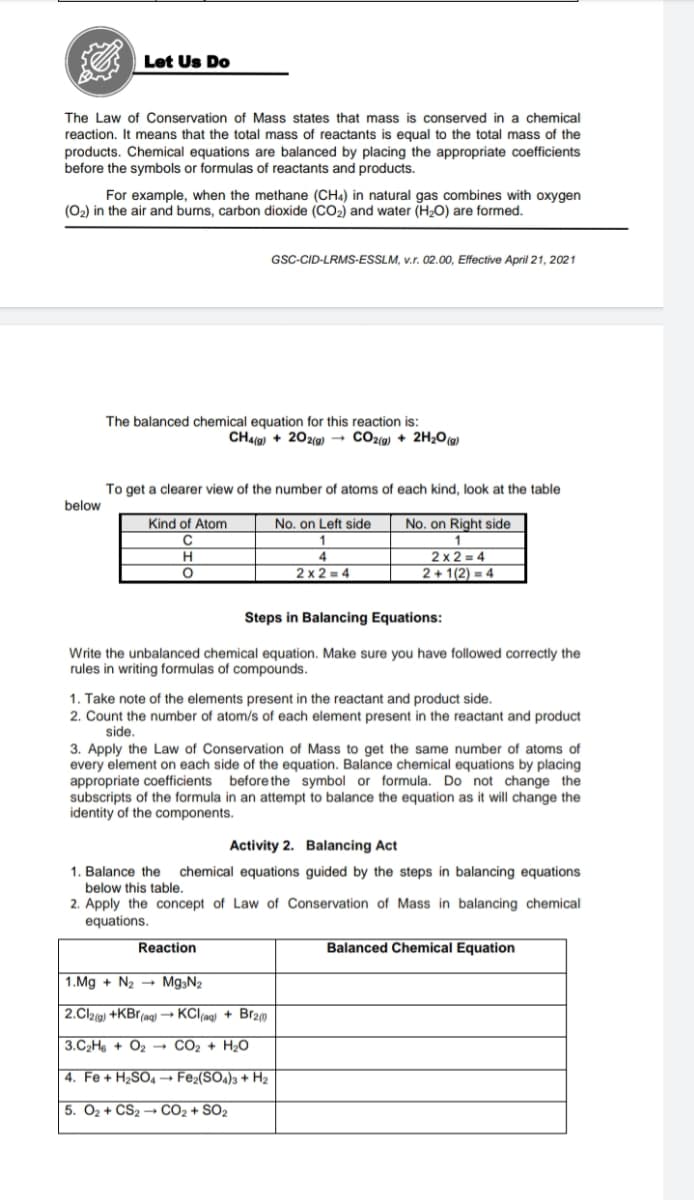Steps in Balancing Equations: Write the unbalanced chemical equation. Make sure you have followed correctly the rules in writing formulas of compounds. 1. Take note of the elements present in the reactant and product side. 2. Count the number of atom/s of each element present in the reactant and product side. 3. Apply the Law of Conservation of Mass to get the same number of atoms of every element on each side of the equation. Balance chemical equations by placing appropriate coefficients before the symbol or formula. Do not change the subscripts of the formula in an attempt to balance the equation as it will change the identity of the components. Activity 2. Balancing Act 1. Balance the chemical equations guided by the steps in balancing equations below this table. 2. Apply the concept of Law of Conservation of Mass in balancing chemical equations. Reaction Balanced Chemical Equation 1.Mg + N2 Mg N2 2.Cl2ig) +KBr(ag) → KCl(ag) + Brz0 3.C2H6 + O2 CO2 + H20 4. Fe + H2SO, → Fe2(SO4)3 + H2 5. O2 + CS2 - CO2 + SO2
Steps in Balancing Equations: Write the unbalanced chemical equation. Make sure you have followed correctly the rules in writing formulas of compounds. 1. Take note of the elements present in the reactant and product side. 2. Count the number of atom/s of each element present in the reactant and product side. 3. Apply the Law of Conservation of Mass to get the same number of atoms of every element on each side of the equation. Balance chemical equations by placing appropriate coefficients before the symbol or formula. Do not change the subscripts of the formula in an attempt to balance the equation as it will change the identity of the components. Activity 2. Balancing Act 1. Balance the chemical equations guided by the steps in balancing equations below this table. 2. Apply the concept of Law of Conservation of Mass in balancing chemical equations. Reaction Balanced Chemical Equation 1.Mg + N2 Mg N2 2.Cl2ig) +KBr(ag) → KCl(ag) + Brz0 3.C2H6 + O2 CO2 + H20 4. Fe + H2SO, → Fe2(SO4)3 + H2 5. O2 + CS2 - CO2 + SO2
Introductory Chemistry: A Foundation
8th Edition
ISBN:9781285199030
Author:Steven S. Zumdahl, Donald J. DeCoste
Publisher:Steven S. Zumdahl, Donald J. DeCoste
Chapter9: Chemical Quantities
Section: Chapter Questions
Problem 44QAP: According to the law of conservation of mass, mass cannot be gained or destroyed in a chemical...
Related questions
Question
Hello tutors, need your help. Just answer Activity 2.

Transcribed Image Text:Let Us Do
The Law of Conservation of Mass states that mass is conserved in a chemical
reaction. It means that the total mass of reactants is equal to the total mass of the
products. Chemical equations are balanced by placing the appropriate coefficients
before the symbols or formulas of reactants and products.
For example, when the methane (CHa) in natural gas combines with oxygen
(O2) in the air and burns, carbon dioxide (CO2) and water (HO) are formed.
GSC-CID-LRMS-ESSLM, v.r. 02.00, Effective April 21, 2021
The balanced chemical equation for this reaction is:
CH4() + 202(g) → CO2(g) + 2H20(@)
To get a clearer view of the number of atoms of each kind, look at the table
below
Kind of Atom
No. on Left side
No. on Right side
C
2 x 2 = 4
2 + 1(2) = 4
4
2 x 2 = 4
Steps in Balancing Equations:
Write the unbalanced chemical equation. Make sure you have followed correctly the
rules in writing formulas of compounds.
1. Take note of the elements present in the reactant and product side.
2. Count the number of atom/s of each element present in the reactant and product
side.
3. Apply the Law of Conservation of Mass to get the same number of atoms of
every element on each side of the equation. Balance chemical equations by placing
appropriate coefficients before the symbol or formula. Do not change the
subscripts of the formula in an attempt to balance the equation as it will change the
identity of the components.
Activity 2. Balancing Act
1. Balance the
chemical equations guided by the steps in balancing equations
below this table.
2. Apply the concept of Law of Conservation of Mass in balancing chemical
equations.
Reaction
Balanced Chemical Equation
1.Mg + N2 → Mg3N2
2.Clzig) +KBr(ag) → KCl(ng) + Br20
3.C2H6 + O2 → CO2 + H2O
4. Fe + H2SO4 → Fe2(SO4)3 + H2
5. O2 + CS2 → CO2 + SO2
Expert Solution
This question has been solved!
Explore an expertly crafted, step-by-step solution for a thorough understanding of key concepts.
This is a popular solution!
Trending now
This is a popular solution!
Step by step
Solved in 2 steps with 2 images

Knowledge Booster
Learn more about
Need a deep-dive on the concept behind this application? Look no further. Learn more about this topic, chemistry and related others by exploring similar questions and additional content below.Recommended textbooks for you

Introductory Chemistry: A Foundation
Chemistry
ISBN:
9781285199030
Author:
Steven S. Zumdahl, Donald J. DeCoste
Publisher:
Cengage Learning

Living By Chemistry: First Edition Textbook
Chemistry
ISBN:
9781559539418
Author:
Angelica Stacy
Publisher:
MAC HIGHER

Chemistry: Principles and Reactions
Chemistry
ISBN:
9781305079373
Author:
William L. Masterton, Cecile N. Hurley
Publisher:
Cengage Learning

Introductory Chemistry: A Foundation
Chemistry
ISBN:
9781285199030
Author:
Steven S. Zumdahl, Donald J. DeCoste
Publisher:
Cengage Learning

Living By Chemistry: First Edition Textbook
Chemistry
ISBN:
9781559539418
Author:
Angelica Stacy
Publisher:
MAC HIGHER

Chemistry: Principles and Reactions
Chemistry
ISBN:
9781305079373
Author:
William L. Masterton, Cecile N. Hurley
Publisher:
Cengage Learning


Chemistry
Chemistry
ISBN:
9781305957404
Author:
Steven S. Zumdahl, Susan A. Zumdahl, Donald J. DeCoste
Publisher:
Cengage Learning

World of Chemistry
Chemistry
ISBN:
9780618562763
Author:
Steven S. Zumdahl
Publisher:
Houghton Mifflin College Div